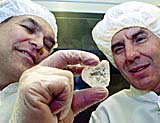
Drs. Russell Vreeland (left) and William Rosenzweig view a salt crystal at West Chester University in West Chester, Pa. They found a 250 million-year-old bacteria in the crystal, discovered near Carlsbad, N.M.
Scientists rouse bacterium from 250-million-year slumber
By Jeff Long, Tribune Environment Writer - Chicago Tribune - October 19, 2000
And it's still alive.
In an article published Thursday in the science journal Nature, a team of scientists laid claim to finding the oldest-known living creature, a single-cell critter that they hope will give insights into evolution and, perhaps, even help answer the question of whether there is life elsewhere in the solar system.
After being awakened from dormancy in a Pennsylvania lab, the single bacterium has been reproducing the way bacteria do -- by dividing itself in half. Then each half divides. And so on.
"They traded sex for immortality," said Russell H. Vreeland, one of the Pennsylvania microbiologists who found the bacterium.
"We have billions of them now," he said. "We can grow them as much as we want."
The pressing question for scientists is how the original bacterium lay dormant for such a mind-bogglingly long time. Oh, scientists found some bacteria spores in the belly of a bee that had been trapped in amber for a mere 25 million or 30 million years. That's nothing compared with this record for longevity.
The newly discovered bacterium is so old that it lived before the continents separated.
"When this thing got trapped in a crystal,
North America wasn't here," Vreeland said. "The dinosaurs came and went
and this thing was still in a crystal. Humanity evolved and this thing
was still in a crystal."
 |
Drs. Russell Vreeland (left) and William Rosenzweig view a salt crystal at West Chester University in West Chester, Pa. They found a 250 million-year-old bacteria in the crystal, discovered near Carlsbad, N.M. |
Vreeland's a scientist, but he appreciates the wonder of it all.
"This thing is cool," he said.
His colleague on the project at West Chester University in Pennsylvania, microbiologist William D. Rosenzweig, was a little more detached. "We were happy that we found something," Rosenzweig said. "But you didn't have to peel us off the ceiling."
"This is really a fabulous discovery," said Dennis Powers, a Texas geologist, "one that the chances of making, from most people's point of view, would be so slim as to not even be worth trying."
But life finds a way to survive in the most inaccessible places.
"Things are not as dead in the Earth as we've always thought," Powers said.
And maybe elsewhere, too, suggested Powers, who helped find the ancient bacterium.
The bacterium was discovered 1,850 feet below the New Mexico desert, 30 miles east of Carlsbad, in a shaft dug for a nuclear waste dump. If organisms can survive for tens of millions of years under what's now New Mexico, Powers said, maybe other organisms have survived under the sandy wastes of Mars.
"If there has been life on Mars or other planets," said Powers, "there may be remains that are still viable -- if we know how to look for them."
Now, apparently, scientists do know how to find them.
The questions that the Carlsbad find raises are fascinating, Powers said. "What is the mechanism by which a bacterium shuts down its systems for 250 million years and continues to survive?" he asked.
That's what biologists Vreeland and Rosenzweig want to find out. From the surrounding rock and other evidence, they can date the salt crystal in which the bacterium was found to about 252 million years ago. And they know the bacterium wasn't metabolizing in the intervening millennia because there wouldn't have been enough nutrients trapped along with it in the seawater inside the crystal.
If it had been metabolizing, Vreeland said, it would have produced waste that would have been toxic to it inside that drop.
"It's a living thing that's doing nothing -- the most akin that I can think of to suspended animation," Vreeland said.
The bacteria are reproducing now, under sterile conditions. The scientists are being careful not to "contaminate" their charges by introducing modern-day bacteria.
Despite their pedigree, the bacteria are hardly prehistoric monsters, or even very flashy.
"It really doesn't do anything in terms of swimming," Vreeland said. "It floats."
The bacteria are related to present-day bacillus, found in soil, water and dust. Finding an ancestor of bacillus gives scientists the opportunity to study the evolutionary changes that have occurred in the intervening 250 million years.
That comparison fascinates Vreeland. "One of the things we usually do when we look at evolution, we look at what we have today and project backwards. In every case we're hypothesizing,"
Now, scientists have an organism from 250 million years ago that they can compare with its modern descendants.
"We have a benchmark," Vreeland said.